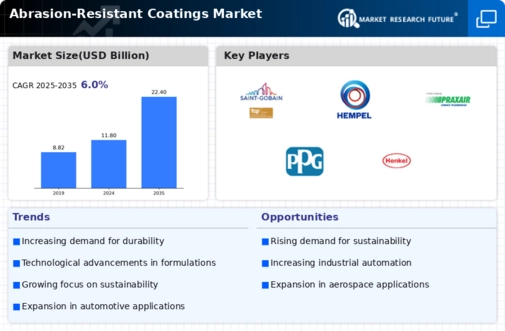Market Trends
Key Emerging Trends in the Abrasion Resistant Coatings Market
The Abrasion-Resistant Coatings market is witnessing significant trends, showcasing an increasing demand and widespread applications across diverse industries. In many different sectors, including manufacturing, construction, mining, among others; Abrasion-resistant coatings are important since they protect surfaces from frictional force wear and tear or impact caused by abrasive materials. This market has seen a major increase in the use of abrasion-resistant coatings within manufacturing plants and machine shops particularly over the last couple of decades. The reason behind this is that companies operating in mining, construction and other industrial fields have been using these coatings to make their equipment more durable under such conditions. This definite inclination can be attributed to high-wear components which require uncomplicated but yet cost-effective ways of maintenance.
Moreover, there is an upsurge for abrasion-resistant coatings driven by aerospace and defense industry demands for them. It is worth noting that airline apparatus undergoes extreme pressures while in flight resulting into some parts getting damaged so quickly. In addition to minimizing wear and tear on vital aerospace sections, these types of coats provide defensive finishings making them more long-lasting too. Moreover, the aviation business’ relentless quest for lighter materials having advanced levels of protection has escalated this trend to optimize performance as well as fuel consumption.
Environmental sustainability has become a critical concern throughout various coating applications as demonstrated by developments in abrasion-resistant market growth strategies. There are increasing calls for environmentally friendly products including those bearing low VOCs (volatile organic compounds). Paint producers spend considerable funds attempting to develop items which not only have excellent resistance to wear but also are compatible with environmental regulations. This shift is part of worldwide initiatives towards promoting sustainable industrial practices.
Similarly, it is important to note that there is a new direction in the market for abrasion-resistant coatings within the automotive industry. Manufacturers are now looking for finishes that have both aesthetic appeal as well as functional benefits in view of continuously evolving designs and materials used in cars today. Bumpers, wheel arches, and interior surfaces are among several automotive parts which need to be covered with such a finish because they have to remain pristine despite repeated use or general wear. In line with its commitment towards delivering long-lasting high-quality vehicles, this development mirrors trends seen in some areas of the automobile business.








Leave a Comment